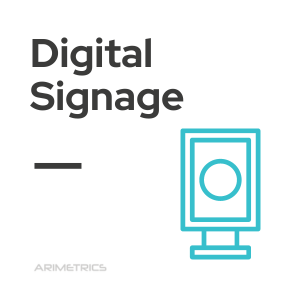
Definition
Digital signage is a modern and dynamic form of communication, which is used to transmit advertising, informative or entertainment messages, through digital screens located in public spaces such as shopping centers, transport stations, museums, restaurants, among others.
This technology has become an increasingly popular tool in the field of advertising and marketing. Thanks to its ability to attract the attention of viewers and generate impact, digital signage is an effective way to promote products or services.
Origin and evolution of Digital Signage
The origin of digital signage dates back to the 70s, when the first screens using LED technology were developed. However, it was not until the 90s when it began to be used for advertising purposes in places such as shopping centers and transport stations.
With the passage of time and the advancement of technology, digital signage has become an increasingly sophisticated and versatile tool. Today, it is possible to use high-definition digital screens, with a resolution equivalent to that of a state-of-the-art television. In addition, technology has enabled the integration of sensors and cameras, providing valuable insights into spectator behavior patterns.
Advantages of Digital Signage
Some of the advantages of digital signage are:
- Attract the viewer’s attention: Digital screens have the ability to capture people’s attention thanks to their brightness, movement and interactivity. This makes it possible to communicate messages effectively and increase the impact of advertising.
- Flexibility in updating content: Unlike traditional media such as newspapers or posters, digital signage allows you to update content in real time. In this way, promotions or updated information can be offered more efficiently and effectively.
- Audience segmentation: Thanks to digital signage technology, you can segment the audience and offer personalized and relevant messages for each group. For example, it is possible to offer promotions aimed at women in a specific area of the mall.
- Increase in sales: Several studies show that the implementation of digital signage in a marketing strategy can increase sales conversion by up to 30%. In addition, the dynamism and call to action of digital screens increase consumer participation and engagement.
- Cost reduction: Digital signage reduces the costs of production and distribution of advertising material significantly in the long term, because it is a digital medium and does not require printing materials. In addition, updating content is cheaper and faster compared to traditional media.
Examples of digital signage
- In the gastronomic sector, digital signage is used to transmit menus, prices, promotions and suggestions of dishes. This allows better communication with the customer and increases the effectiveness of sales.
- In shopping centers, digital signage is used to display promotions, discounts and product recommendations relevant to each area and audience segment. In addition, interactive experiences can be created that engage the customer and increase their commitment to the brand.
- In the tourism sector, digital signage is used to display relevant information about points of interest, events and activities in the area. This helps visitors get the necessary information quickly and efficiently, improving their experience at the tourist destination.
- In companies, digital signage is used to communicate clearly and concisely the policies, objectives and achievements of the organization. In addition, motivational messages can be conveyed and business culture fostered.
- In hospitals, digital signage is used to display information about visiting hours, entry and exit instructions, medical information and relevant health news. This helps improve the patient experience and reduce the stress associated with the hospital visit.
